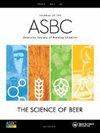The Impact of Lactic and Acetic Acid on Primary Beer Fermentation Performance and Secondary Re-Fermentation during Bottle-Conditioning with Active Dry Yeast
IF 1.8
4区 农林科学
Q4 BIOTECHNOLOGY & APPLIED MICROBIOLOGY
Journal of the American Society of Brewing Chemists
Pub Date : 2021-09-17
DOI:10.1080/03610470.2021.1952508
引用次数: 0
Abstract
Abstract The presence of high concentrations of organic acids is known to adversely affect the efficiency and quality of ethanol fermentation. The growing popularity of sour beers warranted the exploration of strain-specific performance under optimal and suboptimal conditions similar to those found in sour beer production. The focus of this study was on the performance of select active dried yeast strains under artificially acidified conditions. Nine common brewing strains of active dried yeast were assessed based upon overall fermentation performance and their ability to metabolize maltotriose and maltose between 0.0% w/w − 1.0% w/w lactic acid and 0.0% w/w − 0.5% w/w acetic acid. A single strain of active dried yeast specifically selected and bred for bottle conditioning environments was assessed based upon its ability to metabolize glucose, and carbonate artificially acidified finished beer between 0.0%−1.6% w/w lactic acid and 0.0%−1.0% w/w acetic acid. This study confirmed the suitability of active dry brewing yeast for sour beer fermentations that meet or exceed the typical organic acid concentrations encountered in sour wort. The majority of the selected strains performed well in sour wort containing < 0.4% w/w lactic acid or < 0.1% w/w acetic acid. The importance of strain selection became apparent at concentrations exceeding these reported values, with two strains displaying almost no change in fermentation capabilities across the range of organic acid concentrations. Bottle conditioning remained unhindered by lactic acid up to 1.6% w/w, while acetic acid concentrations at and above 0.4% w/w significantly hindered bottle conditioning.乳酸和乙酸对活性干酵母一次发酵和二次复发酵啤酒性能的影响
摘要众所周知,高浓度有机酸的存在会对乙醇发酵的效率和质量产生不利影响。酸啤酒越来越受欢迎,有必要探索在与酸啤酒生产类似的最佳和次优条件下的菌株特异性性能。本研究的重点是在人工酸化条件下筛选活性干酵母菌株的性能。根据总体发酵性能及其代谢麦芽三糖和0.0%w/w之间麦芽糖的能力,评估了九种常见的活性干酵母酿造菌株 − 1.0%w/w乳酸和0.0%w/w − 0.5%w/w乙酸。根据其代谢葡萄糖的能力,对专门为瓶子调节环境选择和培育的单一活性干酵母菌株进行了评估,并在0.0%-1.6%w/w乳酸和0.0%-1.0%w/w乙酸之间人工酸化成品啤酒。这项研究证实了活性干酿酒酵母适用于满足或超过酸性麦芽汁中典型有机酸浓度的酸性啤酒发酵。大多数选定菌株在含有<0.4%w/w乳酸或<0.1%w/w乙酸的酸性麦芽汁中表现良好。当浓度超过这些报告值时,菌株选择的重要性变得明显,两个菌株在有机酸浓度范围内的发酵能力几乎没有变化。高达1.6%w/w的乳酸仍然不阻碍瓶子的调理,而0.4%w/w及以上的乙酸浓度显著阻碍了瓶子的调理。
本文章由计算机程序翻译,如有差异,请以英文原文为准。
求助全文
约1分钟内获得全文
求助全文
来源期刊

Journal of the American Society of Brewing Chemists
工程技术-生物工程与应用微生物
CiteScore
4.00
自引率
20.00%
发文量
41
审稿时长
3 months
期刊介绍:
The Journal of the American Society of Brewing Chemists publishes scientific papers, review articles, and technical reports pertaining to the chemistry, microbiology, and technology of brewing and distilling, as well as the analytical techniques used in the malting, brewing, and distilling industries.
 求助内容:
求助内容: 应助结果提醒方式:
应助结果提醒方式:


